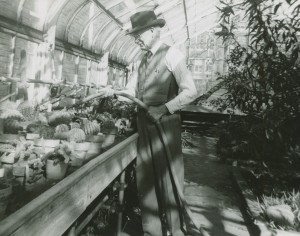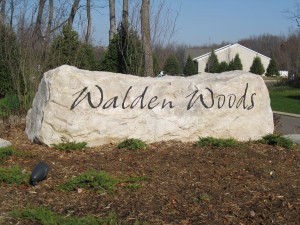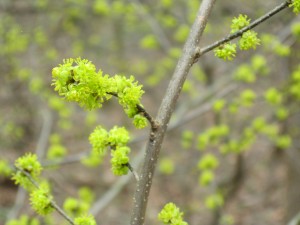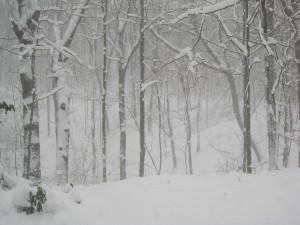
Leslie A. Kenoyer in the greenhouse at West Hall, WMU East campus. Photo courtesy Western Michigan University Archives and Regional History Collection
The essay that follows is a radio address by Leslie Alva Kenoyer, who served from 1922 to 1953 as Professor and Chairman of the Biology Department at Western Michigan University –at that time Western State Teachers College . The piece is dated April 16, 1935. It was written for Western’s Radio Hour, which was evidently a continuing feature on station WKZO.
NEWTON WOODS
Leslie Kenoyer
“Woodman, spare that tree, Touch not a single bough.”
The sentiment that inspired this poem has not been firmly enough established in the minds of southern Michigan people to save from destruction any more than the most scattered remnants of our once beautiful and glorious forest lands. Some fifty thousand years ago the great continental glacier receded from what is now Michigan leaving a raw and barren glacial clay, streaked here and there with sand and gravel. Such soil, in the cool climate then found here, could support only a meager arctic vegetation, consisting of such low, spreading plants as we find today in our cold bogs. The rain and sun gradually brought about favorable chemical changes in the soil and the plants gradually decayed to form humus, hence, in the course of a few centuries, the scant arctic vegetation was replaced by larger shrubs. Centuries later trees occupied the ground, starting with the poplars and developing from stage to stage to dense shady forests of beech and sugar maple. such as covered much of southern Michigan 110 years ago when the government divided our land into townships and sections.
It was inevitable that the trees should succumb to the lumberman’s axe, when the land was cleared for farm homesteads, but it is particularly unfortunate that their removal should have been so complete. Indeed we have here and there a small woodlot to serve as a rather meager sample of the forests that were. but larger tracts are now exceedingly scarce. One of the finest and most extensive remaining areas is Newton Woods in Cass County, adjoining the road from Decatur to Cassopolis, and not far from the village of Volinia. Here are several hundred acres of practically virgin timber, including large blocks of both the beech-maple and oak-hickory types of timber. The trees of this forest were large long before southern Michigan was surveyed and opened to the settler. Among them is an elm which now lifts its head to the majestic height of 150 feet and has a circumference. three feet above ground of 24 feet [91-92 inches in diameter]. Some believe it to be the largest tree now standing in Michigan. There is also a magnificent group of giant tulip or whitewood, the largest of which is 145 feet high, 90 feet to the first branch and 30 feet in circumference [114-115 inches in diameter]. It takes three to five centuries to grow such trees as these.
Ten years ago we could see from our college campus, at a distance of eight or nine miles, a stately elm, towering far above the other trees. Suddenly this tree ceased to be seen, and we learned that it had been sold for $100 for the manufacture of barrel staves. On visiting the stump and counting the rings of growth, I found that the tree was considerably over 400 years old. It was a sapling when Columbus crossed the Atlantic in his puny sailing vessels. Probably the barrels have worn out and the $100 has been long since spent and forgotten, but it will take 400 years to grow another such tree.
When a forest is cut, it is not only the trees that go. The shrubs and the herbs, the orchids and other rare plants, the mosses and lichens that form the turf, will not live when deprived of the shade of the trees. The disappearance of this ground cover permits the erosion of the soil, which represents the accumulation of many thousands of years. The insects, the birds, and the beasts are dislodged from their accustomed haunts, many of them to perish. Hence the restoration of a denuded area cannot be accomplished by the mere planting of trees, nor does a planted forest ever prove a satisfactory substitute for a destroyed native forest. The old conditions will not and cannot be restored, once the forest is gone. How, then, will the next generation know anything of the beauties and glories of the forest with its wonderful variety of plant and animal forms This is a question which our generation must answer.
A part of the Newton Woods is now in the hands of a lumber company and some cutting has already been done, but there is a chance that it may yet be rescued if the public will take sufficient interest in its preservation. The lumber firm is kindly witholding operations in view of an aggressive campaign that is now being sponsored by the Michigan Academy [of Science, Arts, and Letters], the Michigan Forestry Association, and other organizations and individuals who feel that the value to the people of such reserves for the continuation of our wild life is one that cannot be measured in mere dollars. The present leader of this movement is Shirley W. Allen, University of Michigan, Ann Arbor.
Professor Allen would like to hear from all who are interested in finding some means to save the tract. It is well to bear in mind that our present state parks are mostly in northern Michigan remote from centers of population. Here is a real wilderness with immense trees, a small stream, a profusion of wild flowers, birds, and other natural beauties easy of access to a million people. We cannot blame property owners for wishing to realize from their investments, but we deplore the fact that the people are not awake to the desirability of keeping the few remaining bits of out landscape as nature gave them to us, free from the artificial modifications imposed by farm and city development. With an awakened public, our officials and our public-spirited citizens of means would put forth the necessary efforts to save from the general destruction these remnants of wild nature for the instruction and enjoyment of generations yet to come.
Kenoyer’s comments on post-glacial vegetation change hold up well enough as a broad pattern. However, the quoted estimate of 50,000 years ago since the last ice sheet melted from southern Michigan is too high. Something on the order of 15,000 years would be closer to the interval based on current evidence.
I like Kenoyer’s plea for protecting natural areas “for the enjoyment and instruction” of later generations. If I were to revise it I might write “enjoyment, instruction, and health of our own and later generations.” But Kenoyer’s plea for land conservation was accurate and eloquent exactly as he wrote it and, in 1935 on a radio broadcast, far ahead of its time.
The script of this and a few other of Kenoyer’s radio addresses, preserved by Biology Prof. Frank Hinds, have been deposited in the WMU Archives and Regional History Collection
Kenoyer received his Ph.D. in 1916, evidently done in some sort of joint arrangement between the University of Chicago and Iowa State University. He is credited with receiving the first Ph.D. granted by what was then The Iowa State College of Agriculture and Mechanic Arts. Kenoyer’s thesis research dealt with environmental influences on nectar secretion. This and his research interests as shown in later life seem clearly in line with the work being done at Chicago by Henry Chandler Cowles and the other faculty and graduate students.
Kenoyer was born in 1883 in Dover, a small community in north-central Illinois. After completing his Ph.D., he taught botany in India for six years, then spent a year at Michigan State before coming to Kalamazoo. He became head of the Biology Department soon after arriving, when LeRoy H. Harvey died.
Newton Woods was saved by a donation of land (580 acres) and an endowment by Fred Russ in 1939 . The story is complicated (and deserves a thorough treatment by someone), but there is a rough correspondence between the “Newton Woods” of the 1930s and Fred Russ Forest managed by Michigan State University. MSU applies the name “Newton Woods” to 40 acres of old-growth hardwood, the only part of the forest that is protected from timber cutting. E. Lucy Braun in her monumental study Deciduous Forests of Eastern North America (1950. Blakiston, Philadelphia) sampled two distinct areas at Russ Forest, probably in the early 1940s (pp 318-320). One was beech-sugar maple with American elm, black walnut, tulip tree, and several other species well represented. The other was dominated by white oak with sugar maple second and red oak and black walnut tied for third. Evidently, the oak-maple stand is what MSU terms “Newton Woods.”
Whether Kenoyer and some of the other individuals and groups who worked to preserve Newton Woods 75 years ago would be wholly be satisfied with the outcome is not certain.






